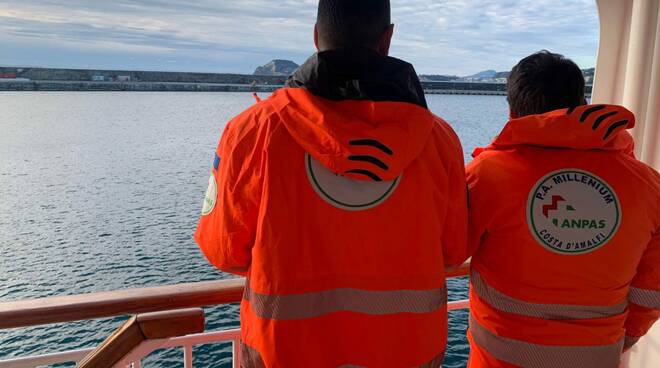Do more and stay less. The new way to see Italy / Fai di più e resta meno. La nuova formula per visitare l’Italia
Più informazioni su

In the past ten years Italy has become the travel destination of the world. With stunning views, good food, and dozens of beaches to cool off at, it’s no surprise that the Amalfi coast has turned into the top tourist destination in the world. Celebrities have been coming here for decades, from John Steinbeck in the 1950’s to more recently Ariana Grande, everyone wants their slice of Italian heaven. In the beginning, Italians were happy to share the beauty of their country with the world and show everyone the Italian way of life.
As an American journalist, I was excited to get an inside look into the culture by interviewing local business and Italian residents. Everyone I interviewed though seemed to say the same thing, there are too many tourists and they don’t stay long enough. At first I thought they meant there was just too much traffic, and growing up in a city I understood what they meant. But by the fourth time someone mentioned it, I was curious and began asking more questions.
I decided to look at three different time periods. I began my research in 2008 which around ten years ago seemed like a good reference point. In 2008, the Italian population was around 59.62 million people. That year, around 41 million tourists also entered Italy either on business or for vacation. These tourists who stayed in hotels on average, stayed about 3.7 days and would spend 418 euros in total on accommodations alone. Others who decided to stay in hostels or airbnbs, spent on average 7.5 days and would spend 225 euros in total on their accommodations. Italian residents who were traveling within Italy would often stay a day longer on their vacations compared to their foreign counterparts.
I then looked at the 2015 tourism statistics. In 2015, the population was around 60.8 million people and saw 55 million people travel to Italy for business or vacation. On average, these people would stay in hotels for 3.8 days or in other accommodations for 6.5 days. The average costs of hotels and other accommodations increased to 413 euros for hotels and 396.5 euros for other accommodations.
Three years later, the national population of Italy was about 59.2 million people. About 63 million tourists came to Italy for work or vacation. This is about 22 million more people in decade who visited Italy. It’s also 8 million people more than the three years prior to it. For reference, there are 8.6 million people living in New York City currently and about 62 million people visit the Big Apple every year. In 2015 alone, more people in the world visited Italy than
The tourists in Italy however would stay in hotels for about 3.2 days, and stay in other accommodations for about 6.2 days. The prices for hotels and accommodations stayed roughly the same from 2015 to 2018 which was surprising considering the drastic increase in tourists.
Even though prices for hotels and accommodations remained the same, tourists wanted an Italian Crash Course rather than living the relaxed lifestyle. Rather than sitting down for the traditional four course meal surrounded by friends and family, they take the tour busses to get a quick glimpse of centuries of culture and history in the shortest amount of time possible. While they learn nothing and experience less, they have the photos on their phone and the instagram picture to go with it. Photographs, rather than experience or relaxation seem to be the main focus of many of the vacations to Italy.
Some business are thriving during this tourist boom. With an increase of 38 euros to average hotel costs in the past decade, this has lead from the 2008 hotel revenue from 5000 million to a 2018 to over 6000 million (according to trading economics findings). Many local business have seen a decreased interest in shopping from tourists in the past decade.
Since tourists are speed-dating Italy, they now don’t have the time to meander through the shops and buy the fashion or art that truly makes Italy so special and unique. While more people walk past the shops, less people stop inside of them.
Locals are also getting frustrated with the way tourists are choosing to see Italy. Families are more and more frequently choosing to travel with large families which then require large cars. Instead of daring to try public transportation, they often go for the private tours or taxi vans. These larger cars or buses can’t fit down the narrow Italian roads. Although that may not stop them from trying. Traffic then builds up causing drivers to be impatient and more accidents to happen.
While tourists spending less time in Italy isn’t the immediate cause of traffic accidents, locals can agree that the increase in accidents and the increase in tourists have a surprising correlation.
Negli ultimi dieci anni l’Italia è diventata la destinazione turistica di tutto il mondo. Con stupende viste, buon cibo e dozzine di spiagge dove potersi rinfrescare non è una sorpresa che la Costiera Amalfitana sia diventata la più gettonata meta turistica nel mondo. Le celebrità frequentano questo posto da decenni, da John Steinbeck nel 1950 fino alla recente visita di Ariana Grande, tutti vogliono un pezzetto di paradiso italiano. Inizialmente gli Italiani erano contenti di condividere col mondo intero la bellezza del loro Paese e mostrare a tutti in che modo gli Italiani vivono la propria vita.
Come giornalista americana, ero estremamente entusiasta di approfondire la loro cultura attraverso interviste alle attività locali ed ai residenti Italiani. Tutti coloro che ho intervistato sembra che dicono sempre la stessa cosa, ovvero che ci sono troppi turisti ma che non rimangono a lungo. Inizialmente pensavo che intendessero ci fosse soltanto troppo traffico ed essendo cresciuta in una città potevo capire cosa significa. Ma alla quarta volta che qualcuno ha ripetuto questa cosa, mi sono incuriosita ed ho iniziato a fare più domande.
Ho deciso di dare un’occhiata a tre differenti periodi di tempo. Ho iniziato la mia ricerca nel 2008 perché dieci anni circa mi sembravano un buon punto di riferimento. Nel 2008 la popolazione italiana era di circa 59.62 milioni di persone. In quell’anno sono anche arrivati circa 41 milioni di turisti sia per lavoro che per una vacanza. Questi turisti sono rimasti negli alberghi mediamente per 3,7 giorni ed hanno speso in totale 418 euro solamente per l’alloggio. Coloro che hanno deciso di stare in ostelli o b&b, sono rimasti in media 7,5 giorni spendendo 225 euro in totale per il loro alloggio. I residenti italiani che viaggiavano all’interno del Paese invece rimanevano un giorno in più rispetto alle loro controparti estere.
Ho poi guardato le statistiche turistiche del 2015. Nel 2015, la popolazione era all’incirca d 60,8 milioni di persone ed ho visto 55 milioni di persone viaggiare verso l’italia sia per lavoro che per vacanze. Mediamente queste persone rimanevano in albergo per 3,8 giorni mentre nelle altre tipologie di strutture rimanevano 6.5 giorni. Il costo medio degli alberghi e delle altre strutture è aumentato a 413 euro per gli alberghi e 396,5 euro per gli altri tipi di alloggi.
Tre anni dopo la popolazione italiana era circa di 59,2 milioni di persone. Circa 63 milioni di turisti hanno raggiunto l’Italia per lavoro o vacanze. In questo decennio sono aumentati di ben 22 milioni coloro che hanno visitato l’Italia. Sono stati anche 8 milioni in più dei 3 anni precedenti. Come riferimento, Ci sono 8,6 milioni di persone che vivono a New York attualmente e circa 22 milioni di persone visitano la Grande Mela ogni anno. Nel solo 2015 quindi moltissime persone nel mondo hanno quindi visitato l’Italia.
Comunque i turisti in Italia rimangono in albergo per circa 3,2 giorni e stanno nel resto degli alloggi per 6,2 giorni. Il prezzo per gli alberghi e per le altre strutture è rimasto praticamente lo stesso dal 2015 al 2018 il che è assolutamente sorprendente considerando il drastico aumento di turisti.
Nonostante i prezzi per alberghi ed altre strutture sono rimasti praticamente identici, i turisti vogliono “Godersi intensamente l’Italia” piuttosto che affrontare uno stile di vita rilassato. Piuttosto che rimanere seduti per il tradizionale pasto da quattro portate, loro prendono dei pullman per poter intravedere rapidamente i secoli di cultura e storia italiana nel più breve tempo possibile. Mentre non imparano nulla ed ancor di meno provano queste esperienze, bastano le fotografie sui loro telefoni e su Instagram per accontentarsi. La fotografia, piuttosto che vivere le esperienze e rilassarsi sembra essere l’obbiettivo principale della maggior parte delle vacanze in Italia.
Alcune attività traggono molti profitti da questo boom turistico. Con una media di 38 euro di aumento sul costo degli alberghi ha aumentato i profitti dal 2008 da 5 miliardi a 6 miliardi (secondo le ricerche economiche). Molte attività locali hanno assistito ad una diminuzione dell’interesse verso lo shopping da parte dei turisti nell’ultimo decennio.
Da quando i turisti hanno deciso di visitare rapidamente l’Italia, adesso non hanno il tempo da dedicare ai negozi e comprare abbigliamento o l’arte che rende unica e speciale l’Italia. Mentre tantissime persone camminano tralasciando i negozi, pochissime si fermano al loro interno.
Anche i locali sono frustrati per il modo in cui i turisti visitano l’Italia. Le famiglie sempre più frequentemente scelgono di viaggiare come famiglie allargate e quindi richiedono grosse auto. Invece di provare ad utilizzare il trasporto pubblico, preferiscono spesso tour privati oppure i taxi. Spesso questi pullman enormi e queste grosse auto non riescono ad attraversare agevolmente le strade strette italiane. Ma ciò non basta a fermarli dal provarci. Ciò quindi implica un aumento del traffico che crea frustrazione nei conducenti ed anche più incidenti.
Mentre i turisti spendono meno tempo in Italia, i comuni comprendono che c’è una correlazione tra l’aumento di turisti e l’aumento di incidenti stradali.




